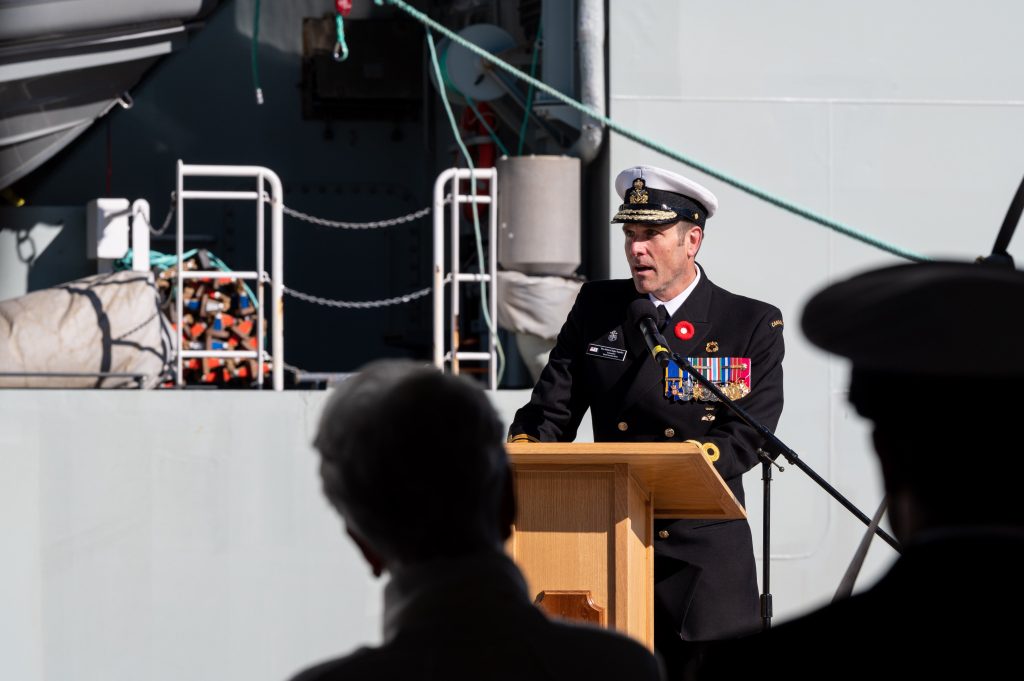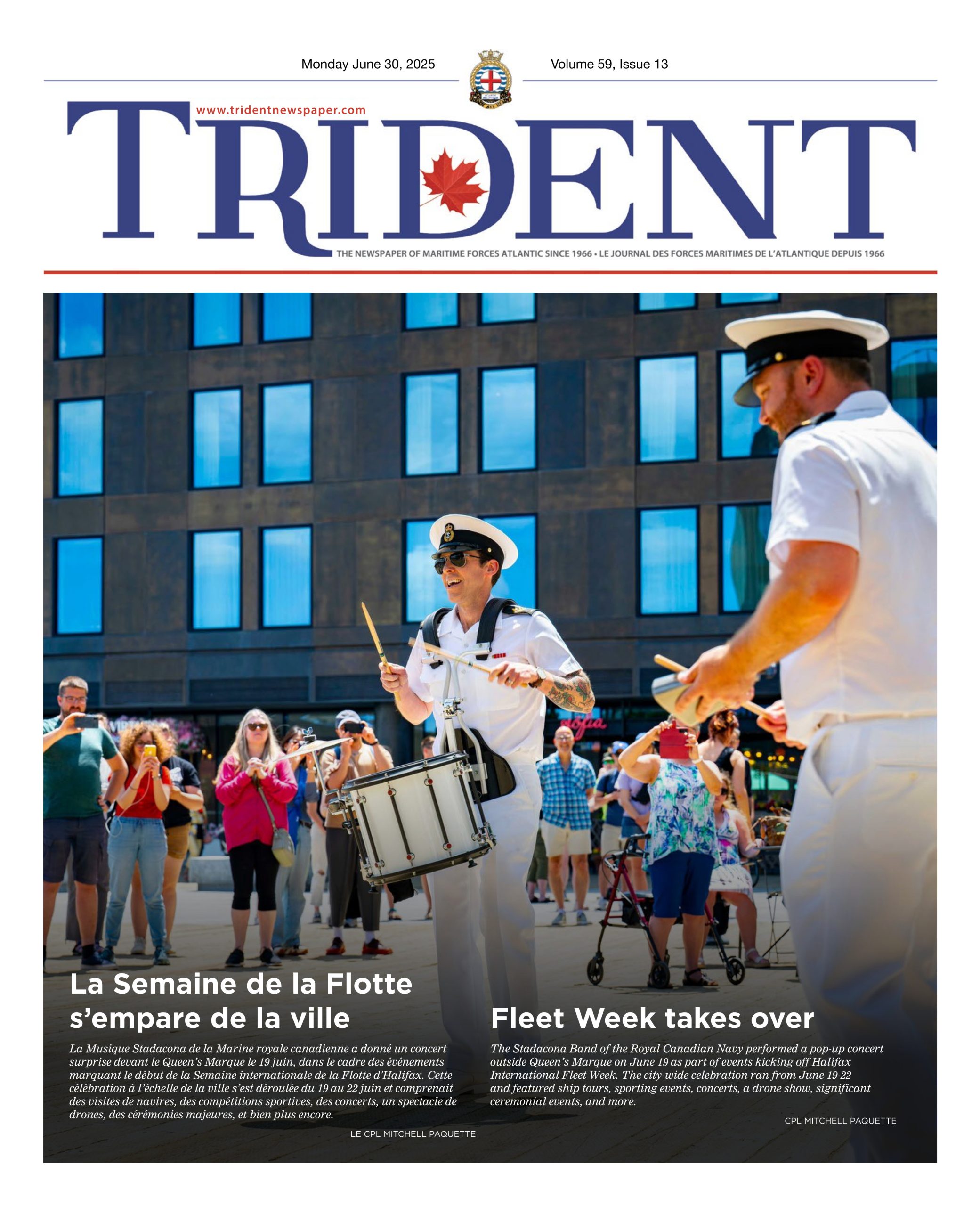
CPL CONNOR BENNETT
The State of the Royal Canadian Navy
The following is a transcript of a video released on November 27 by Vice-Admiral Angus Topshee, Commander of the Royal Canadian Navy (RCN). Click here to watch the video message.
Colleagues and shipmates,
The RCN faces some very serious challenges right now that could mean we fail to meet our force posture and readiness commitments in 2024 and beyond.
This situation is serious, but our problems are not unique, and I know that the Air Force and the Army are facing similar challenges.
Historically we have risen to every challenge, so I’m confident we will find a way to get through this. When I took command, I laid out three priorities: people, platforms and being ready to fight. These remain my focus.
People are the heart and soul of our naval force. History tells us that the best sailors, not the best ships, win at sea. The RCN is in a critical state, with many occupations experiencing shortages at 20 percent and higher. There is a simple reason for this. Despite their very best efforts, CFRG (Canadian Forces Recruiting Group) has not delivered the required intake for the RCN for over 10 years.
While our overall attrition is generally good, one MarTech leaves us every two days. Our West Coast fleet is beset with a shortage of qualified techs constraining our ability to maintain and operate our ships, and causing us to prioritize the Halifax class at the expense of the Kingston class. Challenges in generating techs for the Harry DeWolf class mean that we can only sail one at a time right now. Preparing to fully crew the first JSS by 2025 is a considerable challenge, but we cannot and will not fail.
That is why the highest priority for the RCN is attracting, recruiting and training sailors to the occupational functional point to hold our trained effective strength at its current level. We may not achieve this target this year, and we won’t reach it next year, and we absolutely must start to increase our workforce.
That’s why we launched the Naval Experience Program this past April. Ninety-eight candidates are enrolled with 400 prospects in the recruiting process, helping to address the RCN’s requirement of 1,200 new enrollees this year and every year thereafter. NEP has other benefits. It has engaged our Naval Reserve Divisions in recruiting for the Regular Force. The number of potential applicants at recruiting centers who asked about the Navy has tripled, and we are enrolling three times as many visible minorities and Indigenous Canadians as normal through NEP. It has forced the RCN to better manage all our personnel in the basic training list, which is beginning to deliver an improved experience for all trainees.
We have no choice but to change, and as we undertake the largest peacetime recapitalization in our history, this is the perfect opportunity to reimagine our entire human resources model.
To that end, the RCN has launched a comprehensive analysis to reshape all of our occupations and define the optimal crewing model for our ships. To meet our operational commitments, generate trained sailors, and achieve a sustainable establishment. It is a massive undertaking with key decisions that must be made in the next two years. With respect to platforms, I only have time to talk about surface combatants, but all sea days matter in generating enough sailors who are ready to help lead and most of all, fight.
The Halifax-class frigates are and will remain our only surface combatants for at least the next 15 years. Why? Because we can’t retire the Halifax class until we have at least four Canadian Surface Combatants certified for operations. We have made great progress in the past year because of some tough decisions to prioritize schedule over initial capability, and I am very confident that the first CSC will deliver early in the next decade. This is a massively complex ship, so it will take two to three years of tests and trials to make sure it works well enough to deploy the first one, and years more to have enough to relieve the burden from the Halifax class. We must therefore find a way to keep the Halifax class going until at least 2040.
Given that they’ve reached their design life of 30 years and that all 12 are absolutely required to meet Canada’s commitments to NATO and the Indo-Pacific strategy, this is a very considerable challenge and the reason why the RCN consumes such a massive share of national procurement funds. I wish it was not so, but I’m afraid there simply is no other choice.
These ships play a vital role in ensuring that sailors retain the unique core combat skills that can only be developed, exercised, practiced, and used in surface combat ships. Today’s Halifax Class ships will train the crews of tomorrow’s warships. There is no other path.
We’ve received four of our six Arctic and Offshore Patrol Vessels, and the final two will be delivered in ’24 and ’25 respectively. Last week, Harry DeWolf delivered the Grey Cup to Hamilton with the family of its namesake on board. Like all new ships, they’ve had teething problems, but let me assure you that the AOPVs are outperforming expectations and improving the value of the National Shipbuilding Strategy.
The first support vessel will be delivered in ’25 and the second will follow in ’27. Finally, we launched the Canadian Patrol Submarine Project To replace our Victoria class with a commercial submarine in the mid-30s.
And now to my third and final priority, being ready to fight. The core naval functions are diplomacy, deterrence and defence. We represent Canada abroad and demonstrate our commitment to the rules-based international order. Deterrence is the product of credible capability that is communicated clearly and consistently at sea.
All this is backed up by willingness to use lethal force to defend our nation and its marine interests. Warships are unique in their ability to immediately adapt to emerging tasks or undertake completely new missions without needing new equipment, crew or training. This requires the very best people supported by a diverse, innovative and inclusive culture where everyone is empowered to perform to their full potential and feel a part of our shared success. This culture is not just a slogan, it’s a call to action, a commitment to serve with purpose and pride.
Despite the storm we are currently facing, I know that the future of the Navy is bright and I couldn’t be prouder to serve in this great Canadian institution. Most of all, I want to thank every one of you for everything you do to support the Royal Canadian Navy. We cannot succeed without you.





